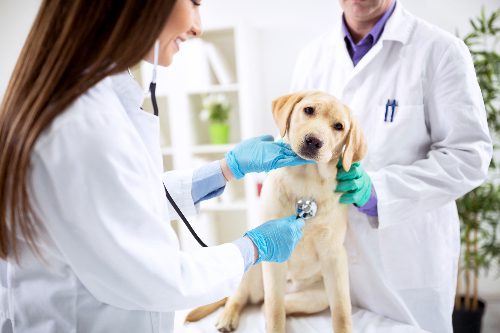10 Causes of Dog Eye Redness and What You Should Do
When your dog’s eyes are red and irritated looking, this can be quite concerning. You cannot always tell if it is due to eye injury caused by a foreign body, infection, allergies, or a congenital problem that can make this condition a chronic one.
Cataracts and glaucoma are serious conditions. If left untreated, they could render your dog blind. When your dog’s vision is at stake, you do not want to take any chances. Your vet can give you guidance to help your pup.

When dogs have eye problems, they will likely have significant discomfort and possibly not function very well. If your dog’s eyes are red, you will need to determine what is causing it and how to treat it. See below for information concerning the causes of dog eye redness and what you should do.
What Can Cause Red Eye in Dogs?
There are many different causes of red eye in dogs. It could be anything from allergies to glaucoma. Red-eye may or may not be accompanied by discharge or watery eyes. Some of the major causes of red eye in dogs include:
Environmental Irritants and Allergens
For the most part, red eyes in dogs are caused by environmental sources. If your dog has allergies around the same time every year, they should get eye drops from your veterinarian to help relieve the eye redness. Some of the significant environmental irritants and allergens that cause red eye include the following:
- Dirt
- Dust
- Seasonal grasses
- Flowers
- Mold
- Smoke
Your dog’s eyes can experience the same irritants that you do, which causes the eyes to become red and swollen. Peak times for your dog’s seasonal allergies include spring and fall.
Trauma
Your dog could have experienced trauma to their eyes. They may be feeling piercing or stabbing pains in the eye if something foreign has come in contact with them. Some examples of causes of traumatic injury to your dog’s eye include:
- Scratches
- Claws
- Nails
- Thorns
- Branches
- Cat scratches
These items can cause swelling on the surface of the eye and the area around the eye. Serious injuries can end in partial or complete loss of eye function, which means you need to get your canine to the vet as soon as possible.
Corneal Ulcer
A corneal ulcer may be triggered by blunt trauma, such as your pup rubbing their eye against the carpet to relieve the itchiness. It could also be caused by your dog’s eye coming in contact with a sharp object. Another cause is chemical burn off the cornea.
A corneal ulcer is very painful, so you must seek treatment for your dog right away. In the least severe case, your dog will need antibiotic drops put in their eyes frequently. In the worst-case scenario, surgical treatment may be required.
Glaucoma
Glaucoma is unusually high pressure in the eye. With this condition, there is constant production and drainage of watery fluid. It causes impairment to the optic nerve, which results in vision loss or blindness. Some of the symptoms of glaucoma include:
- High pressure in the eye
- The eyeball may recede into the skull
- Inflammation of the vessels in the white part of the eyes
- The pupil does not respond to light
The primary treatment of glaucoma in dogs is to decrease eye pressure, control inflammation within the eye, and possibly save their vision.
Uveitis
If your dog has uveitis, they will experience extreme pain in their eyes. There will also be severe reddening of the visible parts of the eye. Some of the symptoms of uveitis include:
- Squinting
- Pawing at the eyes
- Eye redness
- Excessive tearing from discharge
- Change in the pupil
- Change in the color of the iris
- Swelling of the eyeball
Treatment of uveitis includes topical eye medications, repairing any corneal tears, or removing foreign bodies in the eye.
Lens Luxation
The lens is the structure within the eye that focuses light on the retina, which is the area where vision occurs. When dogs have lens luxation, it is a painful and often genetic condition in which the lens slips out of position and moves to either the front or back of the eye.
The eye will usually be very red and may have a touch of blush on the cornea. In most cases of lens luxation, the surgical removal of the lens will most likely provide the best chance of preventing blindness.
Dry Eye Syndrome
This condition is distinguished by the lack of aqueous tear film over the eye’s surface and in the lining of the lids. The result of dry eye is severe drying and inflammation of the cornea and the white part of the eye. This syndrome may also involve excessive blinking and discharge from the eye.
Artificial tear medication and possibly lubricant are the treatment for your dog’s lack of tears.
Conjunctivitis
Conjunctiva is a membrane that protects the eyeball and lines the eyelids. If your dog’s eyes are in good shape, the conjunctiva of the eyelids is not visible, and it is light pink. When conjunctivitis is present, the conjunctival membranes become red and swollen. Treatment may involve eye drops or ointments and oral medications. However, sometimes surgery is required.
Infection
Eye infections in dogs are painful for them. If your dog’s eyes are watering more than usual, or if there is a green or white-colored discharge, they may have an eye infection. Some of the common causes of eye infections include:
- Viruses – This includes distemper, herpes, hepatitis, or canine influenza
- Parasites -Eyeworms are transferred to dogs through contact with certain types of flies
- Bacteria – This includes canine brucellosis, leptospirosis, canine ehrlichiosis, or Lyme disease
- Fungus spores – Fungal infections occur when fungal spores that your pup has encountered have entered their body.
If your dog is experiencing eye problems, you should get them to the vet right away. Treatment of eye infections will help heal their pain and decrease the threat to their eyesight.
Sometimes your dog may be displaying symptoms of typical eye infections, but it might be another condition. You need a vet to diagnose the problem to find out the cause. Some of the other eye conditions that could be occurring include:
Congenital Eye Defects
A congenital eye defect is an irregularity of the eye present at the time of the dog’s birth. Pain, lack of vision, and lesions are a few complications due to an eye defect. Some of the different types of eye defects in dogs include:
- Cataracts
- Generalized progressive retinal atrophy
- Collie eye anomaly
- Primary lens luxation
- Cone degeneration
- Congenital stationary night blindness
- Glaucoma
With many of these eye defects, surgery is the most viable option. Sometimes, removing a portion of the affected eye will suffice, while in other cases, removing the entire eye is necessary.
Dog Eye Redness Should Be Taken Care of Right Away
If your dog has eye issues, you should get them to the vet immediately to be correctly diagnosed, and a course of treatment can be started. It is because there are a plethora of eye problems for dogs, treatment can vary.
Some of these treatments include removing the uncomfortable item from your pup’s eye, prescribing medications, and performing surgery. Regularly cleaning and checking your dog’s (see video) eyes may prevent eye problems.
Prevention is crucial to your dog because if you see a problem, you can get them to the vet right away and get treatment so that nothing serious occurs. As a pet parent, you want to make sure that your fur baby is comfortable and safe.
Recent Posts
Dog Vaccination and Deworming Schedule
Dog Vaccination and Deworming Schedule Vaccinations are a crucial part of your dog’s health care regimen. They…
Do Dogs Need Their Teeth Cleaned?
Do Dogs Need Their Teeth Cleaned? Just like humans, dogs need proper dental care to maintain their…
Can Dogs Have Allergies?
Can Dogs Have Allergies? Allergies in dogs can be as common and as varied as in humans….
About Us
Originally opened as Animal Care Hospital by Dr. Mark Johnston in 1989, the hospital became Cornerstone Veterinary Hospital in 2015 when it was purchased by Drs. Alan and Lisa Knott. The name 'Cornerstone' holds a special place in their hearts, representing not only their Christian faith but also their commitment to being the cornerstone of the community in which they practice. As a family-owned and operated practice, every pet is treated as part of the family, ensuring they receive the highest standard of care. The team at Cornerstone Veterinary Hospital is dedicated to building lasting relationships with clients and their beloved pets, striving to be the cornerstone of the community in which they practice.



